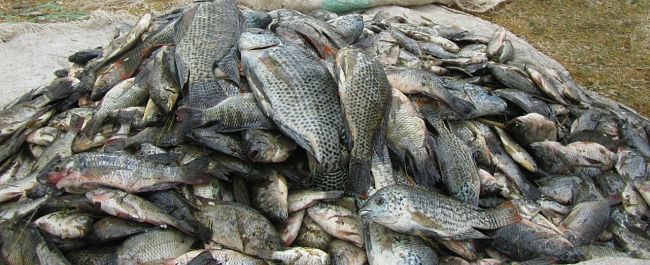Sustainable fisheries, food security: lessons from tilapia fish in Tanzania

Fish production is increasing to meet the protein demands of a growing human population. However, cross-breeding large-bodied native species with small-bodied non-native species can reduce yields and lead to loss of unique biodiversity, with negative consequences for food security.
About the research
Conserving the unique genetic diversity of tilapia is important for future food security.
Nile tilapia is the mainstay of the $10 billion global tilapia industry, and Tanzania is a global hotspot for its wild relatives. These represent a vast source of genetic diversity that could help to protect and improve farmed strains worldwide.
Introduced species, such as the small-bodied, invasive, bluespotted tilapia, threaten Tanzania’s fisheries with reduced production and new diseases. Tilapia Lake Virus, for example, can wipe out up to 90% of fish stocks and has an annual economic impact of $100m in Egypt alone.
This collaborative research between Tanzanian and UK research institutions mapped the distributions of native and introduced tilapia species across Tanzania.
We found evidence of cross-breeding in both fish farms (aquaculture) and the wild (capture fisheries) and revealed contamination of both systems with highly invasive smallbodied tilapia.
This genetic mixing could lead to reduced fisheries harvests and threaten the sustainable aquaculture development needed to keep pace with population growth.
These results underline the need for aquaculture and capture fisheries policies to protect natural biodiversity and harness its valuable role in promoting food security.
Policy recommendations
Improve capture fisheries using indigenous species
• Use only large-bodied native species in wild fisheries to eliminate risk of hybridisation and disease.
Promote sustainable aquaculture expansion
• Distribute only hatchery-validated juvenile fish to avoid contamination with small-bodied invasives.
• Promote zoned aquaculture for smallholders, based on species indigenous to the catchment.
• Restrict use of non-native strains to large commercial farms, which have strong biosecurity.
Make managing biodiversity a priority
• Promote fish identification skills among fisheries, aquaculture and conservation practitioners.
• Identify and protect ark populations of each indigenous tilapia in Tanzania, to conserve genetic diversity.
Why is sustainable fisheries production important?
• In Tanzania, total fisheries production has plateaued at approx. 370,000 tonnes per year.
• Tanzania’s population is expected to rise from 53 million in 2015 to 138 million by 2050. Current aquaculture production will not meet the expected demand.
• Globally, aquaculture has been expanding as wild fisheries have reached maximum capacity.
• Tanzania has substantial scope to build aquaculture development by applying modern technologies, a strategy employed by Egypt - the largest producer of aquaculture products in Africa.
Fisheries production in Tanzania, and globally (data sourced from FAO 2018)
Tilapia are a group of large-bodied freshwater fishes found across Africa, and now widely farmed in tropical and subtropical regions of the globe.
Nile tilapia is the focus of most aquaculture development in Tanzania and the world. It can generate extremely high yields when farmed in optimum conditions, but relying on a single species with low genetic diversity is risky in the face of disease outbreaks.
Even occasional contamination of high-intensity systems can lead to catastrophic losses.
Global tilapia production would benefit from disease-tolerant strains developed using wild relatives, such as those in Tanzania.
In small-scale rural fish farms in Tanzania, broodstock are often sourced from stocks contaminated with less productive species.
Ponds connect seasonally to natural waterbodies, allowing farmed and local species to mix and transfer disease. Uncontrolled breeding leads to inbreeding and accidentally promotes production of small early maturing fish.
Rural aquaculture could benefit from “zoned aquaculture”, where ponds are stocked with large-bodied local native species.
This strategy uses stocks adapted to local climate and pathogens, and genetic diversity of hatchery strains can be maintained by periodically refreshing broodstock from local waters.
Many attempts to improve fisheries productivity of inland lakes have introduced non-native species, without investigating the existing species composition, regional demand for fish, or the water’s maximum productivity.
Introducing new species into lakes with existing large-bodied tilapia is unlikely to dramatically improve capture fisheries potential.
Non-native species in Tanzania: prevalence and impacts
Between 2011 and 2017 we sampled 123 freshwater sites across all major catchments in Tanzania.
• Fourteen species were restricted to their native range, and three species had been introduced beyond their native range.
• Non-native Nile tilapia were found in all major catchments in the country, while the Singida tilapia and Blue-spotted tilapia were also extremely widespread.
• Most sampling locations contained one or more invasive species (67 of 123, 54%).
• Native species persisted without introduced species in almost half the sites (56 of 123, 46%). Many of these sites could be used to establish ark populations for tilapia conservation.
Our results revise the distribution of indigenous species in Tanzania, providing an evidence base for zoned aquaculture.

Across all sites sampled in Tanzania (left) introduced species were common (right)
Positive findings
• The IUCN “Critically Endangered” Jipe tilapia supports many successful fisheries across the Pangani system.
• The IUCN “Vulnerable” Rukwa tilapia supports a highly productive tilapia fishery in the Mtera Dam on the Upper Ruaha
river system.
Negative findings
• Hybridisation between native and non-native tilapia species has been recorded at multiple sites in Tanzania; lakes, rivers,
fish farm ponds and national hatcheries used to distribute broodstock.
• Blue-spotted tilapia is hybridising with the larger species preferred in wild fisheries and aquaculture. This is expected to
lead to declines in body size and profitability of populations in both systems.
Key findings
• Tanzania contains a rich diversity of indigenous tilapia species, many of which have potential as target species within a zoned aquaculture strategy for aquaculture smallholders.
• The native species, and future fish production, of Tanzania are potentially threatened by non-native species that are now broadly distributed across the country.
• There is evidence that several productive fisheries are being supported by critically endangered and vulnerable native species.
• Our surveys allow these ark populations of native species to be identified and protected, enabling their genetic diversity to help with strain improvement that will help commercial aquaculture expand.
• Capacity to reliably identify tilapiine species should be improved among researchers and stakeholders in Tanzania, to improve prospects for sustainable aquatic resource management.
Policy Report 34: September 2018
policybristol-report-34-2018-sustainable-fisheries-tanzania (PDF, 343kB)
Further information
FAO (2018). FAO yearbook. Fishery and aquaculture statistics 2016
Lind, C.E., Brummett, R.E., Ponzoni, R.W. (2012) Exploitation and conservation of fish genetic resources in Africa: issues and priorities for aquaculture development and research. Reviews in Aquaculture 4, 125-141. DOI: 10.1111/j.1753-5131.2012.01068.x
Mushi, V.E (2006) National Aquaculture Sector Overview. United Republic of Tanzania. FAO.
Shechonge, A., Ngatunga, B.P., Bradbeer, S.J., Day, J.J., Freer, J.J., Ford, A.G.P., Kihedu, J., Richmond, T., Mzighani, S., Smith, A.M., Sweke, E.A., Tamatamah, R., Tyers, A., Turner, G.F. & Genner, M.J. (2018) Widespread colonization of Tanzanian catchments by introduced Oreochromis tilapia fishes: the legacy from decades of deliberate introduction. Hydrobiologia DOI: 10.1007/s10750-018-3597-9
Shechonge, A., Ngatunga, B.P., Tamatamah, R., Bradbeer, S.J., Harrington, J., Ford, A.G.P., Turner G.F. & Genner, M.J. (2018) Losing cichlid fish biodiversity: genetic and morphological homogenization following colonisation by introduced species. Conservation Genetics DOI: 10.1007/s10592-018-1088-1
Main image: A commercial catch from Nyumba-ya-Mungu reservoir, dominated by tilapia. Credit: Steph Bradbeer

![]()




Authors
Professor Martin Genner (University of Bristol, UK)
Dr Benjamin Ngatunga, Dr Rashid Tamatamah, Asilatu Shechonge (Tanzania Fisheries Research Institute, Tanzania)
Professor George Turner (Bangor University, UK)
Contact the researchers
Professor Martin Genner, University of Bristol martin.genner@bristol.ac.uk
A field guide and mobile phone app based on this research are now available at: